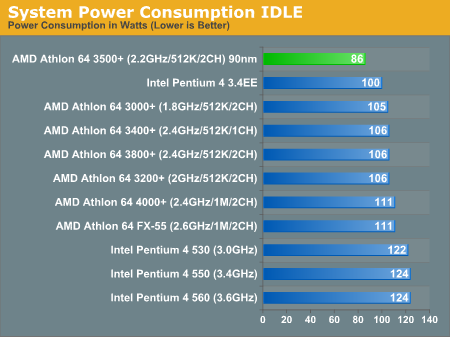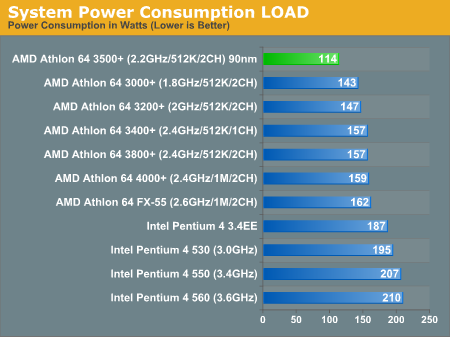AMD Athlon 64 4000+ & FX-55: A Thorough Investigation
by Anand Lal Shimpi on October 19, 2004 1:04 AM EST- Posted in
- CPUs
Power Consumption
To measure power consumption we looked at overall system power consumption and tried to keep as many variables static. There are some basic differences which we cannot get around, mainly that the 925X uses lower voltage DDR-II while the nForce4 uses regular DDR, but for the most part our results were quite controlled. We also included power consumption figures from 130nm Socket-939 Athlon 64 3200+ and 3000+ chips, which as you may know, do not exist. The reason we did this was to show the sharp contrast to the power consumption figures of the 90nm 3500+ we've included in the charts below.
We measured power consumption in two states: idle sitting at the Windows desktop and under load while running our Windows Media Encoder 9 test, which proved to be one of the most strenuous CPU tests we ran as it pretty much isolated the CPU subsystem.
At idle, the 130nm Athlon 64s all consume just about the same amount of power, with the 90nm Pentium 4s doing a little more. But what's truly impressive is the 90nm Athlon 64 3500+, drawing less power than any of the other chips at idle - by a significant margin.

Under load the situation is no different; because of the fact that AMD didn't change anything architecturally (nothing major at least) with the 90nm shrink, the Athlon 64 got what the Pentium 4 should have received with the move down to 90nm - much lower power consumption. However, tack on 32-bit ALUs (as opposed to the 16-bit ALUs in the Northwood Pentium 4), a much longer and more power hungry pipeline as well as logic to support it, and you're looking at a much more power hungry chip. The 90nm Athlon 64 does not suffer this same fate and thus is almost a lower power chip compared to the competition here.











89 Comments
View All Comments
RaistlinZ - Tuesday, October 19, 2004 - link
I may have missed it, but does anyone know if the Athlon 64 4000+ will be multiplier unlocked like the FX-53 is? That's the only thing I see that would differentiate the two chips.RaistlinZ - Tuesday, October 19, 2004 - link
Illissius - Tuesday, October 19, 2004 - link
Re: the necessity of Prescott. You are missing one very important consideration: Prescott has iAMD64 support. (Although it is currently disabled, no doubt because Intel has intentions of selling you the same processor twice). A simple die shrink of Northwood would not.I half suspect one of the reasons for Prescott's problems could be that AMD's 64-bit extensions don't mesh very well with a Netburst architecure, but they had to shoehorn it in anyways, and had to make a lot of unappealing design decisions in the process. (I've never designed a processor, though, so this is just baseless speculation.) I'd be interested in seeing 64-bit enabled chips on a Pentium M architecture...
CrystalBay - Tuesday, October 19, 2004 - link
Moores law is dead...:(Runamile - Tuesday, October 19, 2004 - link
Awsome read. Great Job. And HOLY COW does Intel get their a$$ handed to them!I would of liked to see some price/performance curves too. That would of summed it up quite nicely.
hertz9753 - Tuesday, October 19, 2004 - link
Athlon 64 3700+ 2.4GHz 1MB 64-bitAthlon 64 3400+ 2.4GHz 512KB 64-bit
Athlon 64 3400+ 2.2GHz 1MB 64-bit
araczynski - Tuesday, October 19, 2004 - link
nice, but luckily i still see no reason to upgrade my 2.4@3.3, at least not for a few measly benchmark FPS.hertz9753 - Tuesday, October 19, 2004 - link
AlphaFox - Tuesday, October 19, 2004 - link
Id like to see some kind of comparison with an OC XP Mobile. I have one runing at 2.46ghz and not really sure how it stacks up here...PrinceGaz - Tuesday, October 19, 2004 - link
An excellent article, well done.About the only thing missing was a bit of overclocking of the FX-55 to see if the introduction of strained silicon considerably increased the headroom. Obviously it has allowed them to ship parts rated at 2.6GHz which they weren't previously able to do, but how much better is the FX-55 compared to a CG-stepping FX-53? Does the use of strained silicon mean the FX-55 is a new stepping?